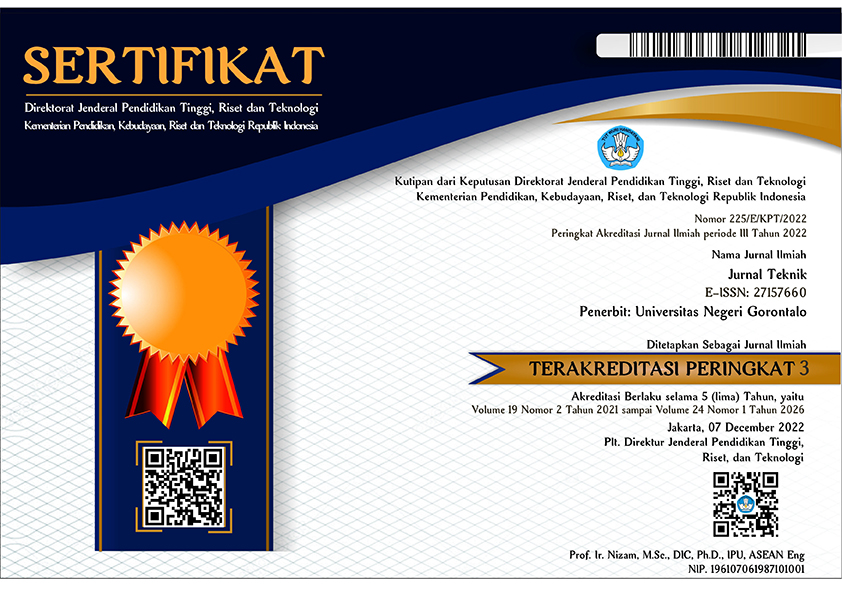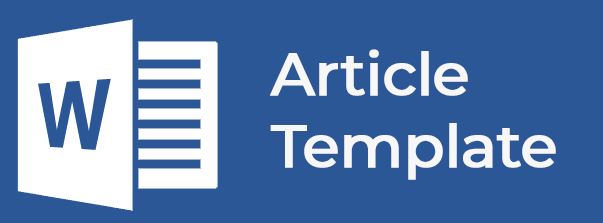Author Guidelines
The manuscript should be the result of research in the field of engineering and educational engineering, more specifically; Civil Engineering, Electrical Engineering, Informatics Engineering, Craft Engineering, Architecture, Industrial Engineering, Mechanical Engineering, Engineering Education, and other related engineering fields.
The manuscript will need to be written and formatted according to the guidelines (using MS Word or OpenOffice Writer). It should be sent using the Online Submission System at https://jt.ung.ac.id/index.php/jt after you have registered as a writer in the “Register” section.
General Guidelines
Manuscript sent to the editors would need to follow the formatting described below. Otherwise, the manuscript will be returned before even being reviewed. These are the general requirements of Jurnal Teknik:
- The manuscript could be written either in Bahasa Indonesia or in English;
- The manuscript should be well written with proper grammar and spelling according to the language used;
- The paper size should be set to A4 (210 x 297 mm). The margins are as follows; left margin: 3 cm, right margin: 3 cm, bottom margin: 3 cm and top margin: 3 cm;
- The font should be set to Arial 11 pt (except for the title and abstract). The paragraph spacing should be set to 1.5. In addition, the paragraph column should be set to 1;
- The title of the article is written in Times New Roman font with a font size of 12 pt, in bold and centred and uses the Capitalize Each Word.
- If the manuscript is written in Indonesian, use Indonesian words for foreign words or terms. If not found, foreign terms are written in italics.
- The first line of new paragraphs begins 1 cm from the left border (indented). In addition, there is no additional space between paragraphs.
- Each heading (i.e. Introduction, Research Methodology, Results and Discussion, Conclusion and References) is not numbered. The headings should be formatted bold, title-cased, centred and not underlined.
- Sub-headings are formatted bold, sentence cased, left aligned and are not numbered. The use of sub-headings should be minimized.
- Images must have enough resolution to be printed clearly.
- Each picture must be given a caption below the image and sequential number of Arabic numerals followed by the image title, as shown in Figure 1;
- Each table must be given a table caption (table caption) and numbered in Arabic numerals at the top of the table followed by the table title, as shown in Table 1;
- Tables must not contain vertical lines, whereas horizontal lines are only given in the table headings and at the bottom of the table.
- Figures and tables and diagrams/schemes should be placed by columns between groups of text or if they are too large place in the middle of the page (one column);
- Each equation is written centred and given a number written in brackets and placed at the end of the right margin. Equations must be written using Equation Editor in MS Word or Open Office. Equations are not permitted to be pasted on the text as images;
- References or citations written in the description/text are in accordance with the APA Style Sixth Edition format;
- The mention of the reference author's name is done by writing the author's last name and mentioning the year, for example as stated in Widianto (2018), (Widianto and Rochim, 2018) as well as by Widianto, et al (2018);
- Reference management applications, such as Mendeley, Zotero or Endnote, should be used by the author when inserting references or making references in the manuscript.
Special Instructions
The manuscript must be composed of the following scientific articles components (subheadings in order), as follows:
- Article Title: The title of the manuscript must be written briefly and clearly, and must show accurately the results of research that has been done, not providing opportunities for diverse interpretations. Article titles may not contain abbreviations that are not commonly used. State the main ideas of the new article first, followed by other explanations;
- Affiliation: All author's full names (consisting of first name and last name) are included in the text without an academic degree. The corresponding author must be marked with an asterisk *). If there are more than one authors, the names of the authors are separated by commas (,). The author's affiliation is written in full under the author's line. Affiliation must not mention the position of the author, for example, lecturers or students. Mark the names of the authors with an affiliate number written in superscript behind the name;
- Abstract and Keywords: Abstract is written in English and Indonesian if the article is in Indonesian. If the article is in English, just write it in English. The number of words is limited to a maximum of 150. The abstract must be as concise, accurate and clear and describe what you are doing and confirm the results of key research/development. English keywords are 3-5 keywords inserted after the English abstract, while Indonesian keywords are inserted after the Indonesian abstract. Each keyword is separated by a semicolon (;).
- Introduction: The introduction must contain (in sequence) a general background, a previous literature review (state of the art) as a basis for the scientific novelty of the article, a gap analysis of what has been produced by the previous researcher and a statement of the importance of your research. At the end of the introduction, the explicit purpose of the article should be stated. In scientific article format, it is not permissible to review the literature as in research report but is manifested in the form of a literature review (state of the art) to demonstrate the scientific novelty of the article. The author must avoid duplicating/repeating unnecessary explanations of his own work/others that have been published.
- Method: The method describes the stages of research/development undertaken to achieve the research objectives. Each stage is briefly explained (for example each stage in one paragraph). Also inform the materials/platforms used in the study, including the subject/material being investigated, tools/software aids used, experimental designs or designs used, sampling techniques, test plans (variables to be measured and data collection techniques), analysis and statistical models used.
- Results and Discussion: Results and discussion contain the findings of research/development and discussion in a scientific manner. Write scientific findings obtained from the results of research that have been done which must be supported by adequate data. The scientific findings referred to here are not the research data obtained. The findings must be explained scientifically include: Are there any scientific findings obtained? Why did that happen? Why is the trend variable like that? All these questions must be explained scientifically, not only descriptive if necessary supported by adequate basic scientific phenomena. In addition, the comparison should also be explained with existing concepts and the comparison with previous studies, whether the research results are appropriate or not, are indicative of improvements or not and other aspects. Research results and findings must be able to answer the research hypotheses in the introduction. In this chapter, it is also advisable to write down the implications of both theoretical and applied research results.
- Conclusions: Conclusions would need to answer the hypothesis and / or research objectives or scientific findings obtained. Conclusions do not contain a repeat of the results and discussion, but rather a summary of the findings as expected in the objectives or hypotheses. If necessary, the direction for future research can be written at the end of the conclusion. Conclusions are stated as paragraphs. Numbering or itemizing are not permitted in this chapter. Subsections (eg A. Conclusions, B. Suggestions) are also not permitted in this chapter.
- Acknowledgements (Optional): Acknowledgments are only addressed to research funders or donors. Acknowledgements can also be conveyed to those who helped carry out the research.
- Bibliography: All references referred to in the article text must be registered in the Bibliography section. The bibliography must contain at least 10 (ten) reference originating from 80% of primary sources (scientific journals, conference proceedings, reference books of research results) published in the last 5 (five) years. The citation format and compilation of the bibliography must follow the APA Sixth Edition format. It is recommended to use a reference management application program, such as Mendeley, EndNote, or Zotero, or others to write references and bibliography in the article text. The following are examples of writing references from various sources.












